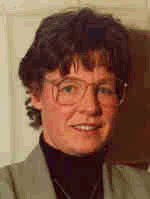![]()

|
Can You Believe It?
When they were not sure what caused the signals they detected, Jocelyn Bell and her college advisor D. Anthony Hewish labeled the signal LGM for Little Green Men. They thought it could possibly be a beacon from an alien source. |
Susan Jocelyn Bell was born in Belfast, Northern Ireland on July 15, 1943. Her father was an architect and an avid reader. Through his books, Jocelyn was introduced to the world of astronomy. Her family and the staff of the Armagh Observatory, which was near her home in Belfast, encouraged her interest in astronomy. Jocelyn Bell's parents very strongly believed in educating women. When she failed the examination required for students wanting to pursue higher education in British schools, they sent her to a boarding school to continue her education.
In 1965, Jocelyn Bell earned a B.S. degree in physics from the University of Glasgow. Later that same year she began work on her Ph.D. at Cambridge University. It was while she was a graduate student at Cambridge, working under the direction of Antony Hewish, that Jocelyn Bell discovered pulsars.
Bell's first two years at Cambridge were spent assisting in the construction of an 81.5-megahertz radio telescope that was to be used to track quasars. The telescope went into operation in 1967. It was Jocelyn Bell's job to operate the telescope and to analyze over 120 meters of chart paper produced by the telescope every four days. After several weeks of analysis, Bell noticed some unusual markings on the chart paper. These markings were made by a radio source too fast and regular to be a quasar. Although the source's signal took up only about 2.5 centimeters of the 121.8 meters of chart paper, Jocelyn Bell recognized its importance. She had detected the first evidence of a pulsar.
In February of 1968, news of the discovery made by Jocelyn Bell was published in the journal Nature. Further studies by groups of astronomers around the world identified the signals as coming from rapidly rotating neutron stars. These objects, first noticed by Jocelyn Bell, became known as pulsars. The term pulsar is an abbreviation for pulsating radio star or rapidly pulsating radio sources.
Jocelyn Bell received her Ph.D. in radio astronomy from Cambridge University in 1968. She married during that same year and changed her name to Burnell. Since leaving Cambridge in 1968, Dr. Bell Burnell has studied the sky in almost every region of the electromagnetic spectrum. She has received many honors and awards for her contributions to science.
Dr. Bell Burnell came to visit NASA's Goddard Space Flight Center in May 1999. She kindly agreed to answer a few questions for StarChild. Hear her responses in her own words:![]() What are your current research interests?
What are your current research interests?
(Text)
![]() What do you think will be the next great discovery in astronomy?
What do you think will be the next great discovery in astronomy?
(Text)
![]() If you had unlimited funding for astronomy investigation, how would you used the money and why?
If you had unlimited funding for astronomy investigation, how would you used the money and why?
(Text)
![]() What surprises you most about the universe?
What surprises you most about the universe?
(Text)
![]() What words of advice would you give young people?
What words of advice would you give young people?
(Text)
![]() Is astronomy a significantly more inviting field today for women?
Is astronomy a significantly more inviting field today for women?
(Text)
![]() Who or what has had the greatest influence on your life?
Who or what has had the greatest influence on your life?
(Text)
![]() What would people be most surprised to find out about you?
What would people be most surprised to find out about you?
(Text)
A QuestionThe telescope that Bell Burnell used to discover the first pulsar generated 121.8 meters of data every 4 days. How much information was generated on chart paper in just 1 day? How much was generated in 12 days? |
| Did you know? |
The Answer |
![]()
| Show me the Level 1 version of this page. |
The StarChild site is a service of the High Energy Astrophysics Science Archive Research Center (HEASARC), within the Astrophysics Science Division (ASD) at NASA/ GSFC.
StarChild Authors: The StarChild Team
StarChild Graphics & Music: Acknowledgments
StarChild Project Leader: Dr. Laura A.
Whitlock
Curator:
Responsible NASA Official: